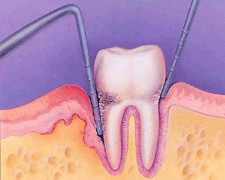المقالات
Gingivitis

Gingivitis is the earliest, most common form of gum disease. There is usually no pain or discomfort associated with it; in fact, 75 percent of adults in the U.S. have gingivitis, and many aren't even aware of it.
Luckily, the effects of gingivitis are reversible, but this isn't the case if it goes untreated. Gingivitis can be the gateway to periodontal disease, a much more serious condition that can lead to irreversible bone loss and ultimately, tooth loss.
Though most people aren't aware that they have gingivitis, the warning signs are redness where the gums meet the teeth, swollen gums, bleeding when brushing and flossing, and persistent bad breath.
To determine whether or not you have gingivitis, we'll perform a thorough examination. We'll look for any changes in the shape, color or contour of your gums, and we'll determine if any bleeding occurs when we gently probe them.
The main cause of both gingivitis and periodontal disease is the accumulation of plaque, the sticky film of food and bacteria that forms constantly on your teeth. You must remove all of the plaque each day, or it builds up and mineralizes to become tartar. Bacteria that thrive in tartar produce toxins; it's these toxins, combined with your body's reaction to them that destroy bone around your teeth. Once bone has been lost, it never grows back.
When too much bone is lost, there's little support for the teeth. They get loose and have to be removed. That's why it's vital that we treat gingivitis early, before it can progress and cause irreversible damage.
If we determine that you do have gingivitis, treatment will always include a professional cleaning, which removes plaque from teeth. We'll also get you started on an effective, consistent homecare regime, and a revisit schedule.
In some cases, additional steps are required, which could include using a disclosing solution to determine where the plaque is, a review of the proper use of floss as well as a manual or electric toothbrush, and using an antibacterial rinse to help kill destructive bacteria.
